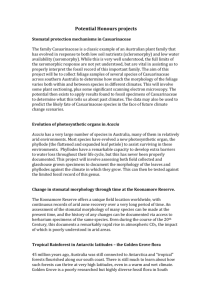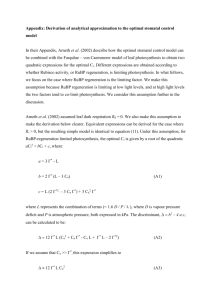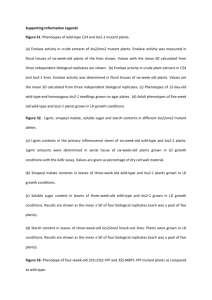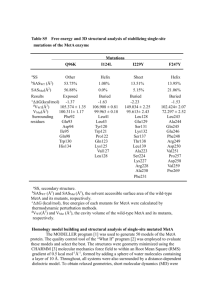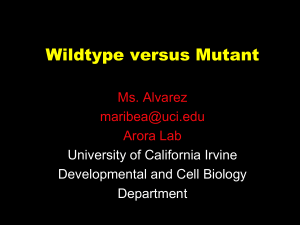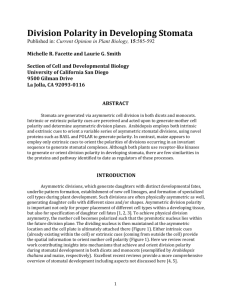tpj12489-sup-0003-Legends
advertisement
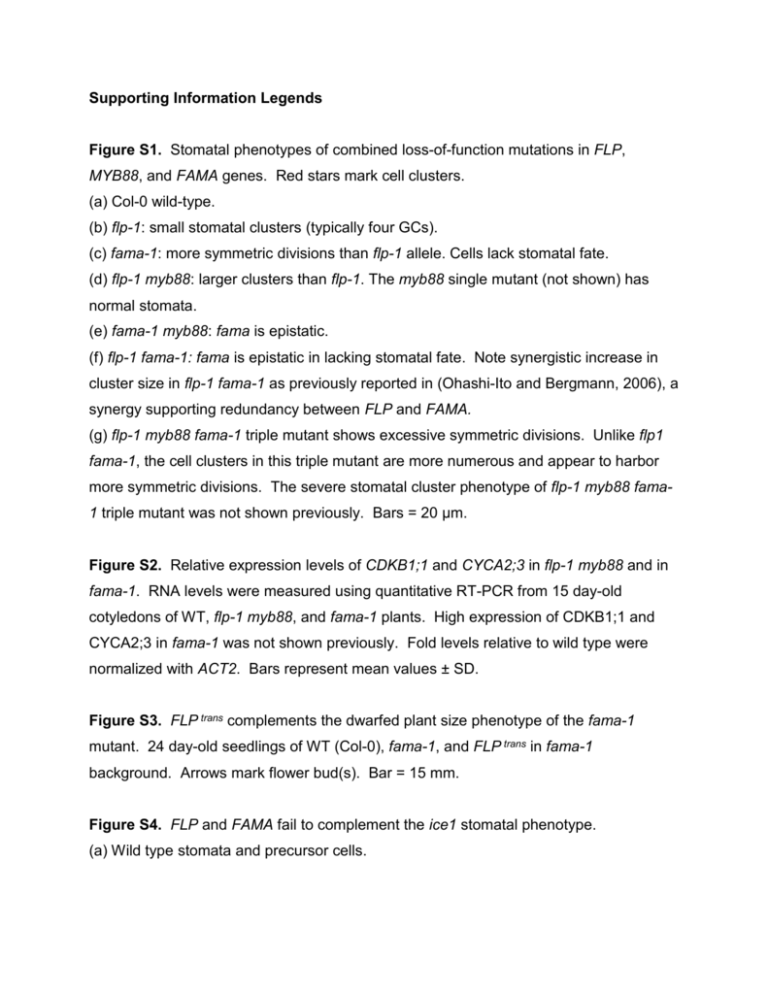
Supporting Information Legends Figure S1. Stomatal phenotypes of combined loss-of-function mutations in FLP, MYB88, and FAMA genes. Red stars mark cell clusters. (a) Col-0 wild-type. (b) flp-1: small stomatal clusters (typically four GCs). (c) fama-1: more symmetric divisions than flp-1 allele. Cells lack stomatal fate. (d) flp-1 myb88: larger clusters than flp-1. The myb88 single mutant (not shown) has normal stomata. (e) fama-1 myb88: fama is epistatic. (f) flp-1 fama-1: fama is epistatic in lacking stomatal fate. Note synergistic increase in cluster size in flp-1 fama-1 as previously reported in (Ohashi-Ito and Bergmann, 2006), a synergy supporting redundancy between FLP and FAMA. (g) flp-1 myb88 fama-1 triple mutant shows excessive symmetric divisions. Unlike flp1 fama-1, the cell clusters in this triple mutant are more numerous and appear to harbor more symmetric divisions. The severe stomatal cluster phenotype of flp-1 myb88 fama1 triple mutant was not shown previously. Bars = 20 µm. Figure S2. Relative expression levels of CDKB1;1 and CYCA2;3 in flp-1 myb88 and in fama-1. RNA levels were measured using quantitative RT-PCR from 15 day-old cotyledons of WT, flp-1 myb88, and fama-1 plants. High expression of CDKB1;1 and CYCA2;3 in fama-1 was not shown previously. Fold levels relative to wild type were normalized with ACT2. Bars represent mean values ± SD. Figure S3. FLP trans complements the dwarfed plant size phenotype of the fama-1 mutant. 24 day-old seedlings of WT (Col-0), fama-1, and FLP trans in fama-1 background. Arrows mark flower bud(s). Bar = 15 mm. Figure S4. FLP and FAMA fail to complement the ice1 stomatal phenotype. (a) Wild type stomata and precursor cells. (b) An ice1 loss of function mutant (ice1-2 allele) exhibits developing clusters that can include stomata (e.g. center right). (c) An ICE1 translational GFP fusion, proICE1:cICE1-GFP, is expressed in the nuclei of many epidermal cells including the stomatal lineage. (d) A proFLP:cFLP-GFP translational fusion does not complement the ice1-2 stomatal cluster phenotype (red arrow). As expected, this translational fusion induces ectopic GC divisions (green arrow). Inset: FLP is expressed in the nuclei of a developing ice1-2 stomatal cluster. (e) A proFAMA:cFAMA-GFP translational fusion in an ice1-2 mutant background induces an ectopic asymmetric division of a GC (green arrow, upper right). Red arrow indicates developing ice1-2 cluster (large black organelles are chloroplasts). Inset in (e): proFAMA:cFAMA-GFP is expressed in a developing ice1-2 stomatal cluster. Bars = 20 µm. Bars in inset of e, f = 10 µm. Figure S5. Protein interactions between MYB88 and RBR, MYB88 and FAMA, MYB88 and ICE1, and FLP and ICE1. RBR interacts with MYB88 as shown by nuclear fluorescence from reconstituted YFP in BiFC assays (images top left). Different combinations of plasmids expressing YFP N-terminal (N) or C-terminal (C) fusion proteins were transiently transfected into Arabidopsis leaf protoplasts. Protoplasts shown in confocal laser microscopy (upper panel), and in Differential Interference Contrast (DIC) optics (lower panel). Bars = 10 µm. Figure S6. proTMM:amiR-RBR in otherwise wild-type plants increases cell proliferation within Meristemoid Mother Cells and meristemoids. Since homozygous rbr mutants are lethal, chemically inducible RNAi constructs against RBR were used instead (Borghi et al., 2010). To explore stage-specific effects of RBR, wild-type plants were transformed with an artificial microRNA against RBR driven by TMM or FAMA promoters. The expression of TMM in the stomatal lineage is high in asymmetric divisions, low in GMCs and young GCs, and absent from mature GCs (Nadeau and Sack, 2002) (Figure S6a). Transformation of wild-type plants with a proTMM:amiR-RBR construct induced the formation of many small cells in contact in developing leaves and cotyledons (Figure S6b-d), cells that exhibited fluorescence from a proTMM:GFP-GUS transcriptional fusion (Figure S6e). proTMM:amiR-RBR plants also harbored ectopic divisions in guard cells, but these daughter cells failed to express either TMM or MUTE expression markers (Figure S6e,g). This result is consistent with a previous report that the induction of an RNAi against RBR resulted in an overproliferation of TMM-expressing cells in Arabidopsis leaves (Borghi et al., 2010). (a) proTMM:TMM-GFP is primarily expressed in stomatal precursor cells including meristemoids (M) and Guard Mother Cells (GMC). SD, symmetric division complete. (b) Leaf epidermis of Col-0 wild-type. (c) Leaf epidermis of proTMM:amiR-RBR plants. Green bracket indicates region harboring many small cells that likely result from asymmetric divisions in the stomatal cell lineage. Red arrows show GCs that have sub-divided. (d) Higher magnification of different region showing many small cells. Asterisks indicate meristemoid-like small cells. Red arrow upper left indicates an ectopic division in a guard cell. Green arrow shows a developing GC pair amidst small cells. (e) proTMM:GUS-GFP in leaf epidermis of proTMM:amiR-RBR plant. Note the absence of GFP expression from TMM in the stoma (white arrow upper right) that appears to have undergone several ectopic divisions. The wild-type like stoma at the left also lacks TMM expression. The smaller cells that express GFP are comparable in type and size to those shown in (c). (f) proMUTE:nucGFP is expressed at the meristemoid (upper left) to GMC (lower right) transition in the wild-type (g) proMUTE:nucGFP appears to be expressed at the correct developmental stage in proTMM:amiR-RBR plants. Arrow: GCs which have divided ectopically due to amiRRBR expression fail to exhibit proMUTE:nucGFP fluorescence. Confocal laser scanning micrographs of living epidermis. Cell walls visualized using propidium iodide fluorescence. Bar = 20 µm. Figure S7. FAMApro:amiR-RBR induces ectopic divisions in guard cells in a too many mouths mutant background. (a) Wild-type leaf epidermis. (b) tmm-1 showing large numbers of stomata in contact. (c) proFAMA:amiR-RBR in wild-type background. Red arrows show abnormal divisions within GCs. (d) proFAMA:amiR-RBR in tmm-1 mutant background. Red arrows, abnormal divisions of GCs. A similar ectopic division phenotype is also present in wild-type plants harboring proFAMA:amiR-RBR. Bar = 20 µm. Figure S8. Model for functional redundancies between FLP and FAMA in stomatal development. (a) Direct transcriptional control of common cell cycle target genes e.g. CDKB1 by FLP and FAMA (Xie et al., 2010; Hachez et al., 2011; Figure S2). (b) Indirect interactions between FLP and FAMA via RBR in sustaining GC fate. Table S1. Primers used.

